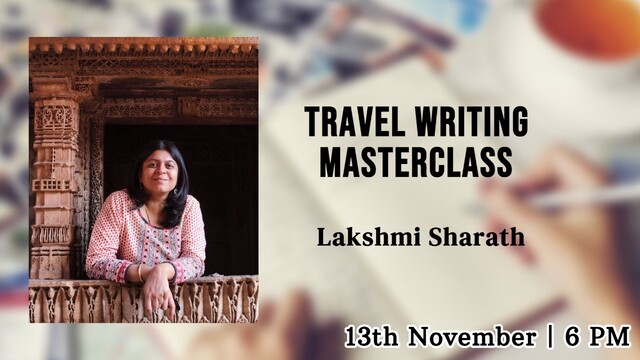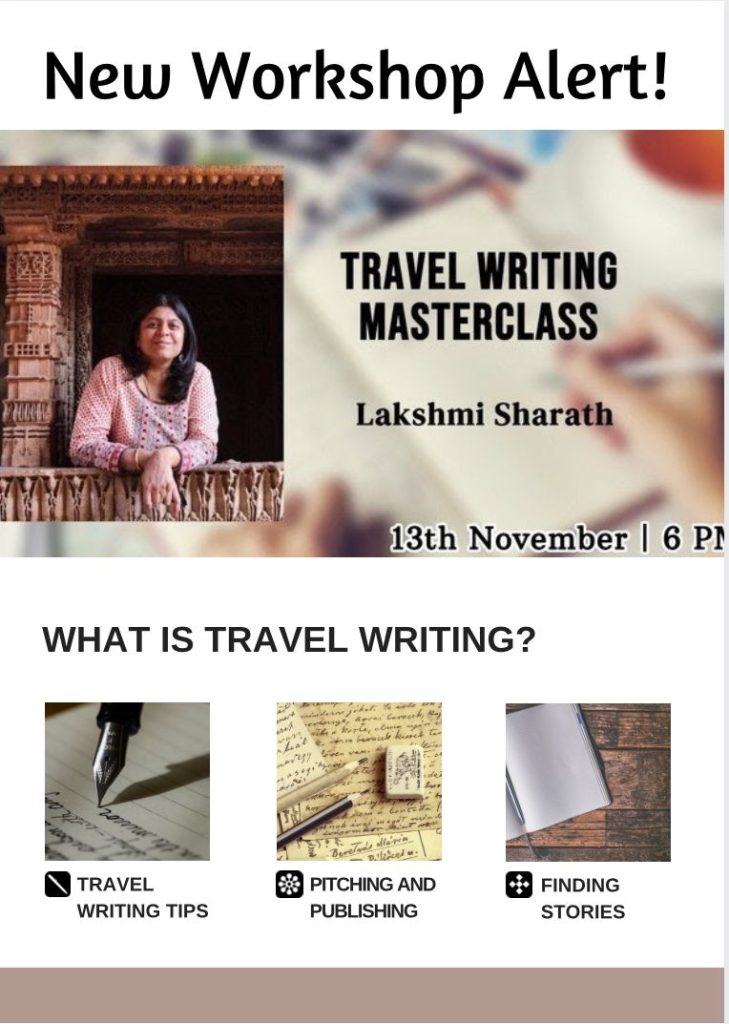“I didn’t want to be a travel writer,” says Bill Bryson. “I mean that wasn’t my ambition. I just stumbled into that genre.” While some of us may have like the prolific author found our calling through serendipity, we need to constantly hone our skills out there. As a writer, I have always believed that there are just two ingredients that help you become a better travel writer – Reading and Writing. Travel Writing is a lot of hard work. It’s not just about sitting in a fancy destination and waiting for the words to magically form themselves on the screen. And whether you want to write books, articles, blogs, or even instagram posts, travel writing keeps evolving. And that is why I decided to do this collaborative post with professional travel writers and bloggers who share some very insightful travel writing tips.
But before that, here is a workshop alert for you – I conducted a Masterclass on Travel Writing that will cover some of the most important aspects of travel writing. And you can still watch it even if you have missed it. Register here or mail me at [email protected] for details

Some of the topics that we covered are
– What is Travel Writing – Types of travel writing
– Ten Travel Writing Tips
– The Three I’s of Travel Writing
– How do I find travel stories?
– All about pitching and getting published
– Does travel writing pay?
– Difference between travel writing and travel blogging

Pic Courtesy – Rawpixel.com, Shutterstock
And as promised here are some of the expert travel writing tips shared by the best travel bloggers and writers that I admire
Divyakshi Gupta, one of the most prolific travel writers and blogs as Quirky Wanderer shares a very valuable tip on the simplicity of style.
One of the best tips I can give for travel writing is to write in a simple language. This makes the writing relatable and more readers can identify with your write-up. It is often a misconception that using flowery language or difficult words gives a travel write-up depth. What is the point of the write-up if the reader has to sit with a dictionary to understand each line? After a point, the reader loses interest and the entire point of travel writing is to keep the reader hooked till the end! Lucid writing is one of the best ways to keep the audience involved.
Mridula Dwivedi, who blogs at Travel Tales from India and abroad and has been blogging for over 15 years shares one of the travel writing tips which gives an insight on who we write for
We often wonder who is our audience while writing. Is it my sponsor? It is the people who read my blog? I started blogging in 2005 when it hardly had any audience. I wrote for myself. And then it became a habit. I still write for myself.
Indrani Ghose who blogs at I Share These has also been blogging for over a decade and her tip gives more insight on writing narratives
For travel writing best would be to adopt a narrative form. We divide our content into headings and subheadings. Try and run a thread through the different sections of this format so that there is a sense of continuity. Let them be not independent paragraphs. Lead your readers’ attention from the start till the end of the narration of your travel story. While the introduction, body, and conclusion parts of the writing are important, a smooth transition from one part of the writing to the next makes it very enjoyable.

Pic Courtesy – Rawpixel.com, Shutterstock
Anita Rao Kashi, another prolific travel writer who pens several travel articles both for Indian and international publications speaks about the nuances of travel writing
Travel writing to me is about connection. Connection to people, places, culture, environment. Ultimately, it is this connection that moves, enriches, and expands me and I seek to convey this sense of connection to the reader. I hope, in turn, to pass this along and enthuse others to step out, travel, and experience the sense of wonder and fulfillment that I experience. For this, it is essential to be open-minded and open to cues, nuances and develop an acute sense of observation. Watch for anything and everything that is different from one’s own experience and look for tools that will help in conveying as much as the senses take in.
Jeroo and Gustasp Irani, one of the earliest travel writers and who has inspired almost every travel writer and blogger speaks of the importance of storytelling and the role of locals and personally for me, this is one of the most valuable of all travel writing tips.
We like to talk to colourful characters, locals, tourists, shopkeepers, restaurateurs… in order to get revealing insights into a place.If you have the time, sit at a cafe and people watch. However, most often, time is limited on a fam trip which is generally hosted by a national tourism organization. Create the time to talk to people, explore the place on your own, duck into an alley not marked on a map or a hole-in-the-wall tea shop whose owner may have secret family recipes for milky tea or pyaaz (onion) kachori, going back several decades. This will help you to get under the skin of a place. When you talk to locals you will connect with them and the destination in a way that mere online research cannot. Unearth marvelous stories about their personal lives, their passions, the highs, and lows… perhaps gain insight into local cuisine, a dying craft…
I personally believe in the Three I’s of Travel Writing when it comes to storytelling – Immersive, Informative, Inspiring. And there are more travel writing tips in the workshop on travel writing. Here is the
link to register. Look forward to seeing you there.







